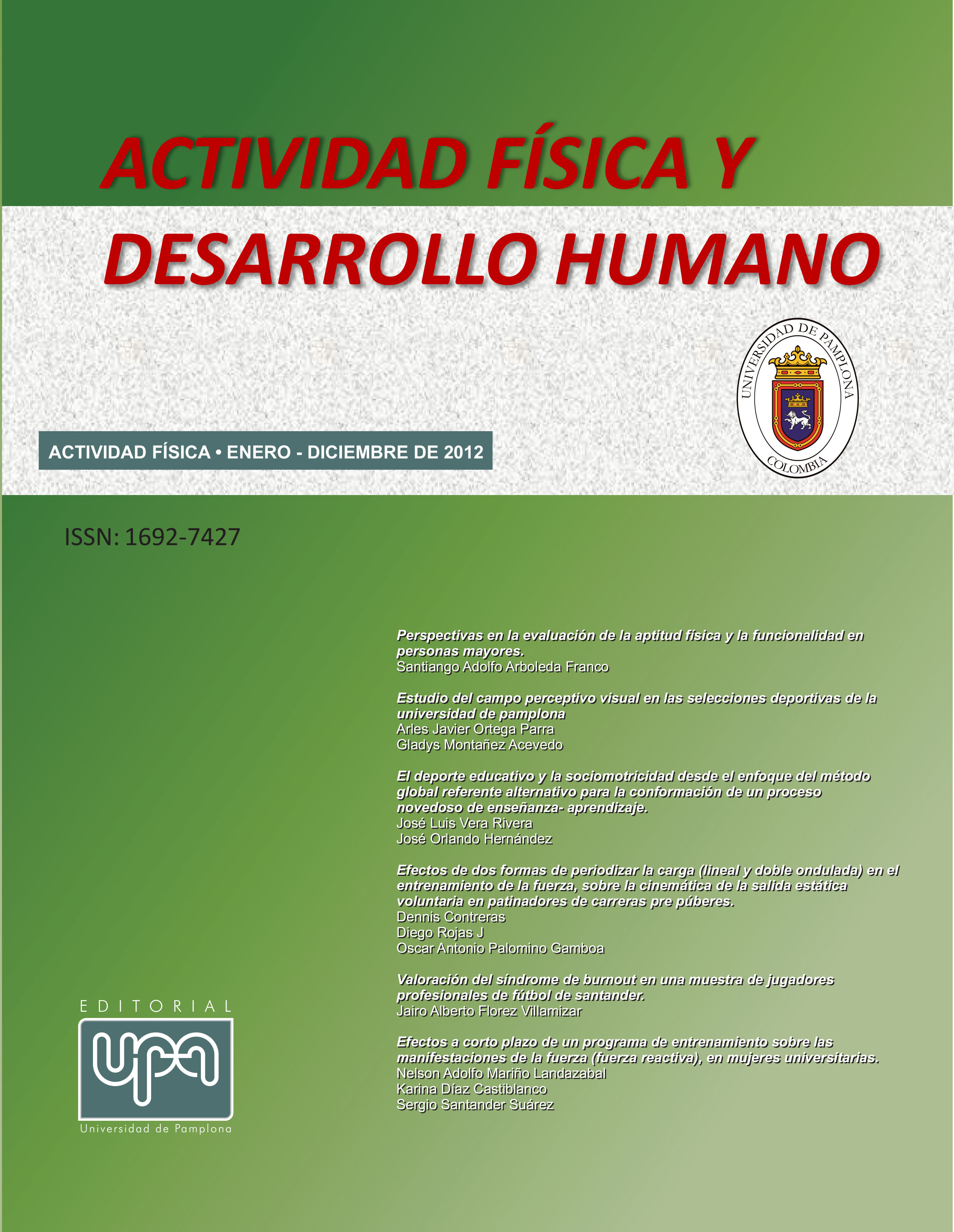Efectos a corto plazo de un programa de entrenamiento sobre las manifestaciones de la fuerza (fuerza reactiva), en mujeres universitarias
DOI:
https://doi.org/10.24054/afdh.v4i1.1713Palabras clave:
Fuerza reactiva, genero (mujer), adaptación, entrenamiento MaxexResumen
A continuación expondremos los resultados obtenidos al aplicar un plan de entrenamiento con el método Maxex (combinación fuerza y potencia) de forma lineal, sobre la fuerza reactiva en mujeres universitarias. Teniendo en cuenta, como primera medida, el desarrollo de la fuerza en general en la mujer a través de los estudios e investigaciones realizadas previas a nuestra intervención. Sin embrago, y a pesar de los resultados arrojados, nuestro objetivo no es establecer la efectividad o no de este tipo de método sobre el incremento en la fuerza reactiva en la mujer; por el contrario nuestro principal objetivo, se centra en determinar los efectos de este tipo de entrenamiento sobre las manifestaciones de la fuerza, en este caso, la fuerza reactiva como una de las manifestaciones en las mujeres evaluadas. A partir de la aplicación del plan de entrenamiento a 12 semanas se obtuvo como resultados un porcentaje de mejora superior al 50% en los grupos experimentales, y a su vez una diferencia altamente significativa *** (P<=0.001), entre los grupos experimentales con respecto al grupo control.
Descargas
Referencias
Aramburuzabala, P., Cerrillo, R., & Tello, I. (2015). Aprendizaje-servicio: Una propuesta metodológica para la introducción de la sostenibilidad curricular en la universidad. Revista de Currículum y Formación de Profesorado, 19(1), 78–95.
Aveleyra, R. (2023). Informe regional: Educación superior en América Latina. CLACSO.
Banco Interamericano de Desarrollo. (1996). Higher education in Latin America and the Caribbean: A strategy paper. Social Programs Division; Social Programs and Sustainable Development Department.
Banco Mundial. (1994). Higher education: The lessons of experience.
Blancas, E. (2018). Educación y desarrollo social. Horizonte de la Ciencia, 8(14), 113–121.
Brunner, J. J. (1990). Educación superior, investigación científica y transformaciones culturales en América Latina. En BID-SECAB-CINDA (Eds.), Vinculación universidad-sector productivo (Colección Ciencia y Tecnología, No. 24).
Brunner, J. J., & Miranda, D. (Eds.). (2016). Educación superior en Iberoamérica: Informe 2016. Centro Interuniversitario de Desarrollo (CINDA).
Chidichimo, G. (2022). La educación superior universitaria en América Latina: Tendencias y nuevas configuraciones en los inicios del siglo XXI. Journal de Ciencias Sociales, 10(18), 143–148.
CINDA. (2016). Educación superior en Iberoamérica: Informe 2016. Santiago de Chile: Centro Interuniversitario de Desarrollo.
Cossa, J., et al. (2024). La educación superior desde el Sur Global. CLACSO. https://biblioteca-repositorio.clacso.edu.ar/bitstream/CLACSO/250905/1/Educacion-superior-Sur-Global.pdf
CRESALC-UNESCO. (1996). Declaración sobre la educación superior en América Latina y el Caribe.
CRESALC-UNESCO. (1997). La educación superior en el siglo XXI: Visión de América Latina y el Caribe (Tomo 2, pp. 671–672). Caracas: CRESALC-UNESCO.
Ensuncho, G. (2021). Tendencias, desafíos y oportunidades para la transformación de la educación superior en América Latina. Revista Dialogus, 5(8), 107–116.
Fernández, N. (2004). Hacia la convergencia de los sistemas de educación superior en América Latina. Revista Iberoamericana, (35), 39–71.
Fernández, N., & Pérez, C. (2010). La autonomía universitaria en Argentina y América Latina: Análisis y propuestas para configurar la reforma universitaria necesaria para el siglo XXI. En Autonomía universitaria a debate: Una visión desde América Latina (pp. 51–80). Guadalajara: Universidad Autónoma de Guadalajara.
Freire, P. (1983). Pedagogía del oprimido. México: Siglo XXI Editores.
García, C. (1997). El valor de la pertinencia en las dinámicas de transformación de la educación superior en América Latina. En CRESALC-UNESCO (Ed.), La educación superior en el siglo XXI: Visión de América Latina y el Caribe. Caracas: CRESALC-UNESCO.
Sánchez Cordero Dávila, O. M. del C. (2023). Iniciativa con proyecto de decreto por el que se expide la Ley General de Mecanismos Alternativos de Solución de Controversias. https://www.senado.gob.mx/65/gaceta_del_senado/documento/132036
Secretaría de Gobernación. (2016). ¿Qué es la justicia alternativa? https://www.gob.mx/segob/articulos/que-es-la-justicia-alternativa-19298
Tunnermann, C. (2011). La universidad del futuro. Managua: HIPAMER/UPOLI.
UNESCO. (1995). Documento para el cambio y el desarrollo en la educación superior. París: UNESCO.
UNESCO. (2002). América Latina y el Caribe: Informe regional. Estadísticas de la educación. París: UNESCO.
UNESCO. (2006). Decenio de las Naciones Unidas de la Educación para el Desarrollo Sostenible (2005–2014): Plan de aplicación internacional. París: UNESCO. https://unesdoc.unesco.org/ark:/48223/pf0000148654_spa
UNESCO. (2008). Tendencias de la educación superior en América Latina y el Caribe. https://unesdoc.unesco.org/ark:/48223/pf0000161990
UNESCO. (2017). TIC, educación y desarrollo social en América Latina y el Caribe. París: UNESCO. https://unesdoc.unesco.org/ark:/48223/pf0000262862
UNESCO. (2021). Reimaginar juntos nuestros futuros: Un nuevo contrato social para la educación. París: UNESCO. https://unesdoc.unesco.org/ark:/48223/pf0000379381_spa
Vilches, A., & Gil, D. (2012). La educación para la sostenibilidad en la universidad: El reto de la formación del profesorado. Revista de Currículum y Formación de Profesorado, 16(2), 25–43.
Vitale, C. (2019). Políticas, tensiones y tendencias de la educación a distancia y virtual en América Latina. Salta: EUCASA-Ediciones Universidad Católica de Salta.
Zubiría, J. (2013). Cómo diseñar un currículo por competencias. Bogotá: Editorial Magisterio.
Nava González, W., & Breceda Pérez, J. A. (2017). Mecanismos alternativos de resolución de conflictos: Un acceso a la justicia consagrado como derecho humano en la Constitución mexicana. Cuestiones Constitucionales, (37), 203–228.
Descargas
Publicado
Número
Sección
Licencia
Derechos de autor 2012 ACTIVIDAD FÍSICA Y DESARROLLO HUMANO

Esta obra está bajo una licencia internacional Creative Commons Atribución-NoComercial-SinDerivadas 4.0.











